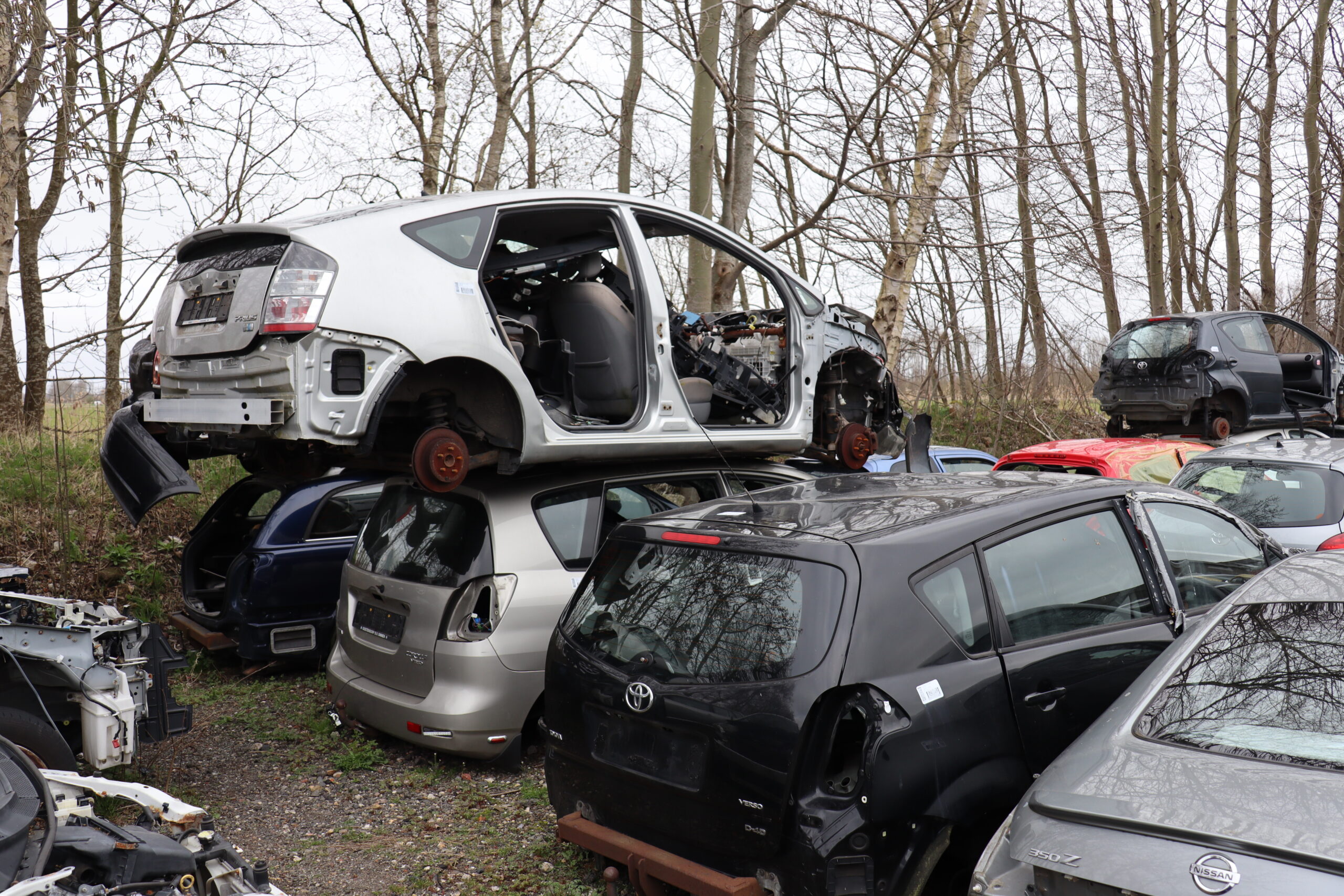It is well known that Dutch car recycling chains are achieving exceptional performance. But what is the situation in other countries? The editors of Green Light struck out to investigate, this time in Colombia.
Tekst Jens Holierhoek
A lunar landscape: it might be the best way to describe the roads in the Colombian capital, Bogota. The city’s network includes an impressive 15,000 kilometres of roads, 5,000 of which have been designated by the government as poor quality. Taken together, these sorry stretches have around 120,000 potholes, ranging from tiny depressions to full-on craters. Fail to pay attention, and you may find yourself stranded with a blown tyre or a busted axle. Looking on the bright side, though, you’re unlikely to hit a pothole with any kind of speed. This is because Bogota is plagued by virtually permanent trancones: traffic jams. Which isn’t so strange when you consider that the metropolis is home to over eight million people.
Pico y placa
Permanent traffic jams notwithstanding, Colombians love their cars. Crawling through the city at a stop-and-go pace is still better than the alternative: the overcrowded TransMilenio bus system. And cycling? That’s something for at the weekend, or if you can’t afford a car. In the city, the group that canafford a car will encounter pico y placa,a measure intended to reduce traffic congestion. Due to heavy traffic, residents are only allowed — based on their number plates — to drive during rush hour every other day. On paper, it’s a good system, but in practice it is thwarted by the use of taxis and the purchase of a second vehicle: one car for Monday, Wednesday and Friday and a second, with different plates, for the other days. Because Colombians aren’t going to give up their cars willingly.
Commercial recycling
But even in Colombia, the automotive idol has to tumble from its pedestal sooner or later. And what happens then? Because no local can shed any light on this matter (which is a sign in itself), our investigation of the Colombian car recycling industry starts online. Right away, the name ‘CESVI’ pops up. CESVI stands for Centro de experimentación y seguridad vial, which translates roughly as ‘traffic safety research centre’. It may sound like a government agency, but it’s not. In fact, CESVI is a Spanish concern with centres in France, China, Mexico, Brazil, Argentina and here, in Colombia. The primary goal of these CESVI centres is to ‘conduct research aimed at improving the reparability of vehicles’. A telephone call to CESVI Repuestos Colombia, the branch office tasked with car recycling and the selling of parts, puts us in contact with CEO Mauricio Ruiz Correa.
Laissez faire government
We learn that CESVI — which has had a branch office just outside the capital, Bogota, since 2010 — is the only organisation in the country that recycles cars in a professional and environmentally-friendly way. Officially, this location is the only office in Colombia, although there is an affiliated car recycling business near Medellin, a city with a million inhabitants. That facility is run by one of the founders of CESVI Bogota. Together, the two centres have access to a huge potential market. The total ‘fleet’ in Colombia numbers some 4.7 million passenger vehicles for a total of 50 million residents. Yet the CESVI centre in Bogota recycles no more than 30 cars each month. Mauricio Ruiz Correa emphasise that, as a commercial enterprise, CESVI is playing a pioneering role in Colombia: “The government has set out precious few regulations with regard to the recycling of passenger vehicles, and doesn’t practice any recycling itself. In fact: the cars it takes off the road after serious traffic violations or police interventions are left to rust on the scrap heap. And there are no subsidies in place for recycling companies, either.”
“No one could say the Colombian car recycling business is a lucrative one”
This means that CESVI must find its own means of support. And the possibilities aren’t exactly generous. Every car the company takes in for recycling costs around 2.5 to 3 million pesos, equivalent to between 750 and 900 euros. While the trade in parts naturally generates revenue, no one would call the business a lucrative one. Ruiz Correa: “CESVI feels a social responsibility to see that cars are recycled and that this is done in an environmentally-friendly way.”
Higher purpose
If they’re barely profitable and receive no government support, how can CESVI survive? Ruiz Correa points out that the initiators behind CESVI are a group of nine insurance companies, united in a partnership for that purpose. Together, those nine parties insure 89 per cent of all vehicles with all-risk coverage in Colombia. If a car insured by one of the partners is involved in a traffic accident and can no longer be repaired, CESVI Repuestos steps in. For what it’s worth, cars aren’t declared a ‘total loss’ very often in Colombia. According to Ruiz Correa, an impressive 95 per cent of damaged vehicles in Colombia are repaired; only 5 per cent are candidates for a one-way trip to CESVI. CESVI does not process cars that are fully depreciated due to age. With any luck, those vehicles will wind up in the alternative parts market.
Trade in parts
Once a car reaches CESVI, it is in good hands. First, the vehicle is drained of all fluids — such as motor oil, battery acid, coolant and the last drops of petrol — which can be highly damaging to the environment. Next, the employees remove all parts that are non-functioning, but may be useful in other industries: things like plastics. After that, any parts that can be reused are dismantled. Whether it’s windows, doors or entire engines: these parts are destined for a second life in the parts market. Ruiz Correa: “We reuse about 30 to 35 per cent of each car, assuming the car is in relatively good shape when it comes in. After all, we’re dealing with cars that have seen some rough treatment.” Any parts that pose a safety risk will be excluded from resale. “It doesn’t matter if they appear to be in good shape or not; we never resell airbags.”
Vision for the future
With its stated recycling volume of no more than 30 cars a month, CESVI is anything but big business. If we assume CESVI’s counterpart in Medellin processes a similar number of vehicles, the conclusion is that a maximum of 700 cars are properly recycled in Colombia each year. The rest wind up on the scrap heap or in the hands of quick-and-cheap parts dealers. The latter pull any valuable parts out of a junked car and ignore or discard the rest. A sad state of affairs, and a waste.
“A maximum of 700 cars are properly recycled in Colombia each year. The rest wind up on the scrap heap or in the hands of quick-and-cheap parts dealers.”
When asked about the future of car recycling in Colombia, CESVI responds with more realism than optimism. It’s not planning to expand its activities. The required investments would be too large and the rewards too small. What CESVI does plan to do, however, is invest in greater cooperation with the government. “Our goal is to see more laws and regulations governing car recycling and the parts trade,” Ruiz Correa says. And CESVI hopes to be a role model in that area. “We want to show people that Colombia is able to set up a sustainable car dismantling industry, too. Even if it’s expensive and we face competition from the street trade, who don’t have the same high overhead costs.” It would be fantastic to see car-mad Colombia truly embrace environmentally-friendly car recycling. So that their beloved vehicles can be ‘laid to rest’ in the best possible way when their useful life is over.





